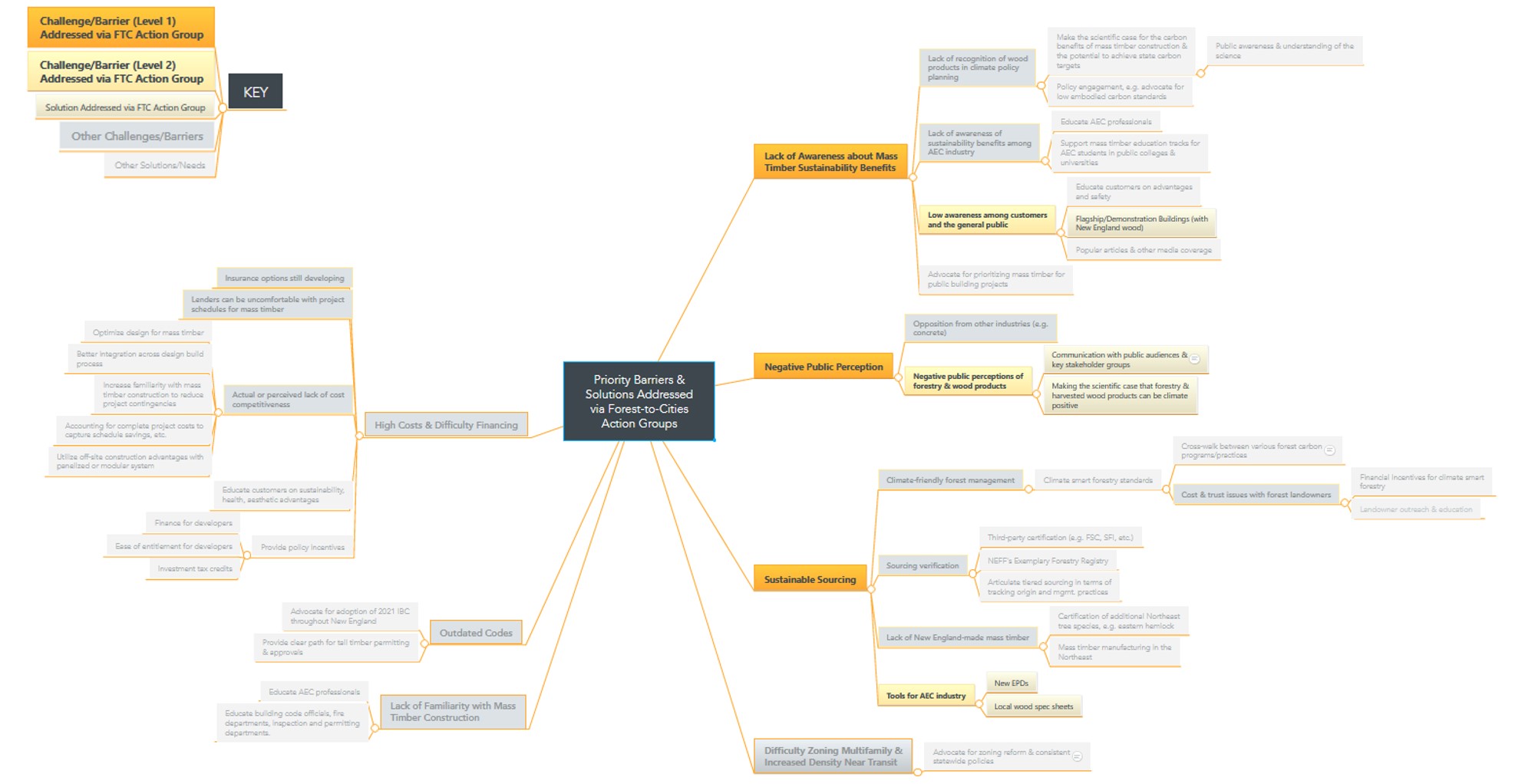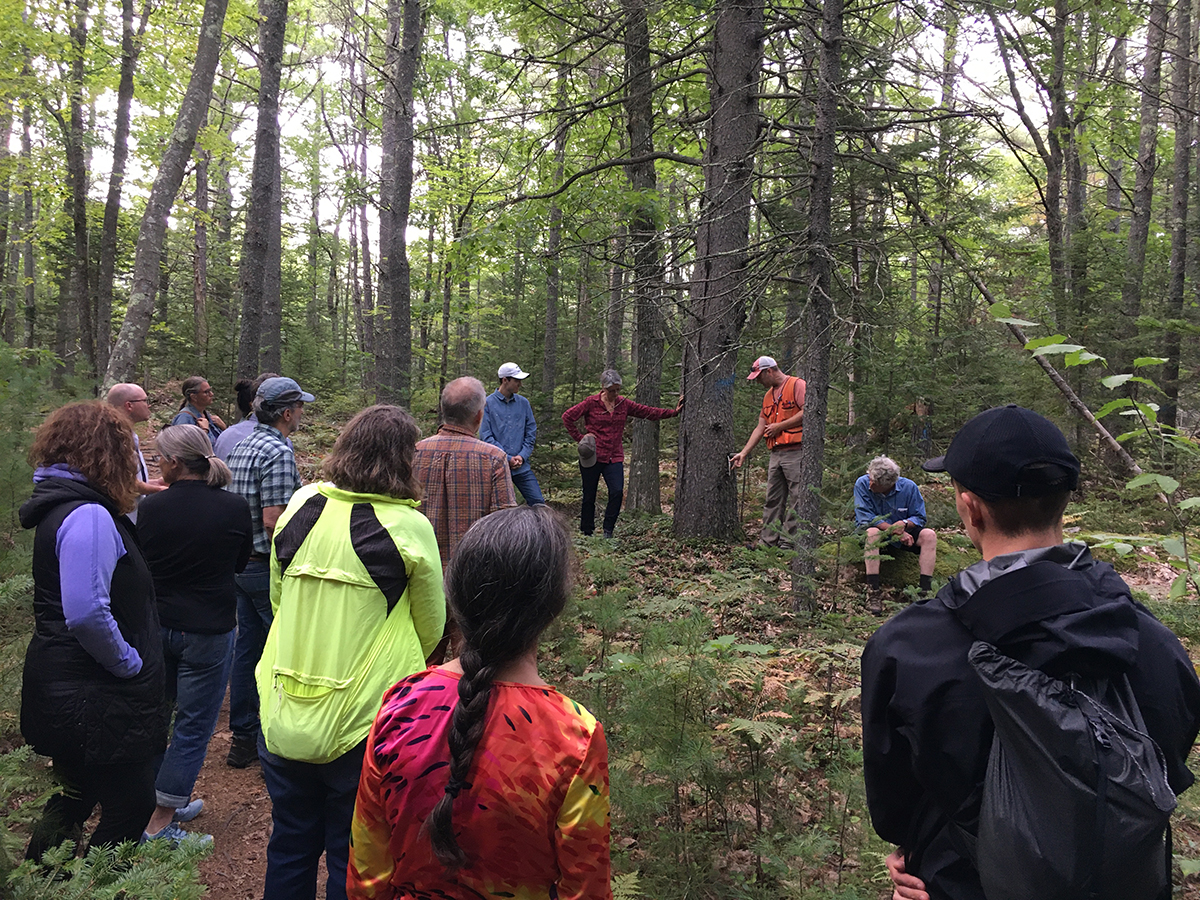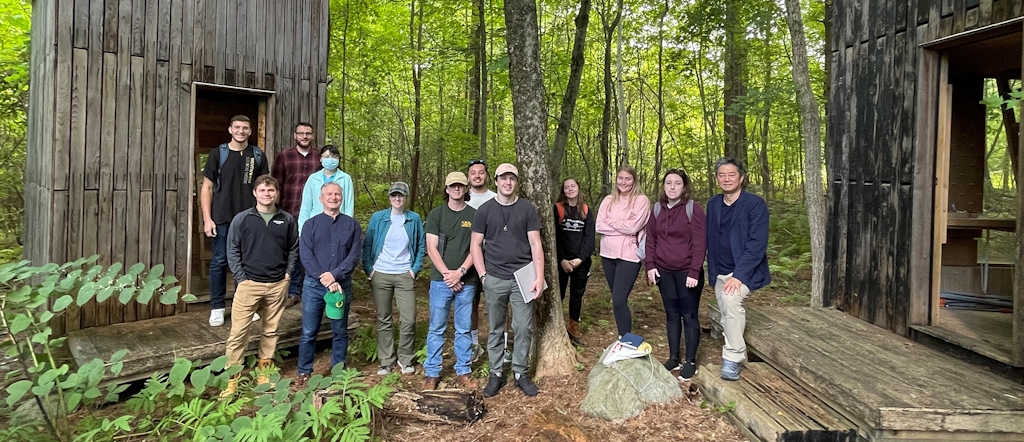Writing by NEFF Forest Policy Fellow Connor Rockett and NEFF Climate-Forest Specialist Jen Shakun
Top photo: Architecture graduate students from Wentworth Institute of Technology toured NEFF’s Prouty Woods property in Littleton, MA this summer and learned about sustainability in the mass timber supply chain.
New England Forestry Foundation’s Forest-to-Cities Climate Challenge (FTC) is helping to solve the climate crisis by linking mass timber buildings in New England with local forests that generate the wood for them. This approach will support affordable, high-quality housing and rural jobs, while maximizing the potential of both forests and cities to mitigate climate change. The FTC community is made up of more than 125 organizations and individuals, most with expertise in relevant fields and some with well-received enthusiasm and curiosity, that have committed to this vision by signing the participant pledge.
After a year and a half of growing the program, we began a new FTC phase over spring and summer 2021 with a series of events—including outdoor excursions—designed to leverage the knowledge and zeal of participants for developing forest-based climate solutions. Read on to learn more about our progress and how you can take action with the FTC community!
Kickoff Event
On April 20 and 27, we held the first virtual gatherings of the FTC community via webinar. Participants joined to get inspired, connect with others, and help inform a strategy for climate action that connects our rural and urban communities in a common goal. The April 20 session included an overview of the Forest-to-Cities vision, a guest speaker presentation with follow-up panel discussion, and a summary of how FTC fits into the growing number of initiatives focused on the carbon footprint of forestry and the built environment.
That informational deep-dive set the stage for the second session on April 27, which solicited input and insights from participants. We discussed the challenges for accelerating climate-smart forestry and mass timber in the region and asked for input on a set of strategies the FTC program can implement in the near-term. You can view the recording for the first session by clicking here and the second by clicking here.
Sector Meetings
We continued the momentum of the kickoff event with the Grow, Build, and Live Sector meetings. Participants from different sectors—or the economic sectors that make up the pathway from forests to cities, such as forestry, mass timber manufacturing and architecture—joined them to identify a number of near-term solutions for accelerating climate-smart mass timber construction in New England.
- In May, the Grow Sector meeting focused on the key barriers and solutions the FTC community can pursue at the beginning of the supply chain related to regional sourcing and demand.
- In June, the Build Sector meeting focused on solutions related to the construction, design, and sourcing processes for sustainable mass timber buildings.
- In July, the Live Sector meeting focused on how forest products can contribute to more livable urban environments, including helping with smart growth goals, building more densely to limit sprawl, and reducing greenhouse gas emissions.
Through facilitated discussion, we prioritized the potential solutions and established three action groups (or AGs) around the most promising ideas. AG members are now working to advance those solutions with NEFF’s support.
The mindmap diagram below, also available in a live format here, provides a visual representation of the barriers and solutions discussed during the Sector meetings. The highlighted cells show the focus areas that participants identified for AGs. Cells in gray represent areas for potential future engagement, but are not currently a direct focus for the AGs.
As you can tell, there is a great deal of problem-solving that needs to happen to achieve the FTC vision. We use these mindmaps to help orient our strategic thinking in how we approach these tasks. We encourage you to explore the mindmaps linked in this post to learn more about these challenges and how our AGs are addressing them.

A “mindmap” diagram of barriers to achieving Forest-to-Cities Climate Challenge goals, as well as potential solutions. Click the diagram to view a PDF version.
FTC participants discussed the barriers and solutions in the mindmap above. Highlighted cells were identified during the sector meetings as priority areas for the AGs to address. A live version of this mindmap is available here.
Action Groups
Following the Sector meetings, our three action groups are now leading the charge to bring the FTC vision to life. The Demonstration Buildings AG is addressing the lack of awareness about the sustainability benefits of mass timber by working to bring New England-sourced mass timber into new buildings and to highlight existing buildings in the region. Members of the group are hosting building tours and woods walks (example photos above and below) to introduce new people to engineered wood construction, the forest products supply chain, and the forestry practices that produce sustainable materials. Thanks to the involvement of our AG members, we are reaching an entirely new group of architecture and design professionals. These relationships have greatly expanded the impact of the FTC community and opened doors to new opportunities for collaboration.

Members of the Portland Society for Architecture learned about NEFF’s Exemplary Forestry practices and sourcing local wood products at Bliss Woods in Freeport, ME.
The Communications and Research AG is developing communications tools and opportunities to inform key audiences about the value of forestry for producing renewable, bio-based material that supports lower-impact construction. Members of the group are hosting presentations on mass timber for real estate developers; creating a two-page document aimed at policy makers and advocacy groups; and developing videos, graphics, and animations to convey key information in an accessible, visual format. We are thrilled to have these presentations and communications resources available to amplify our message and engage new audiences in developing the local mass timber supply chain.
The Sourcing Tools and Guidelines AG is addressing challenges related to sourcing climate-friendly wood products by developing resources to facilitate that process. The group formed in fall 2021 and brings together members with expertise in green building systems, local wood products, and low-embodied carbon architecture. This AG will help to meet the practical needs of design professionals who want to build with local wood, enabling them to drive positive change in the supply chain with their projects.
Get Involved
All of this work is only possible with the engagement of FTC participants. If you would like to join the FTC community, you can sign the participant pledge and visit our section of the website to learn more. By signing the pledge, you will become an official member of the FTC community, receive news and invitations to events, and, most importantly, get connected with opportunities to take action. As the climate crisis accelerates, we all must work together to advance solutions here in New England and around the world. The FTC community is helping our forests and cities meet this challenge. Now is the time to join and we hope to connect with you soon!


